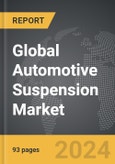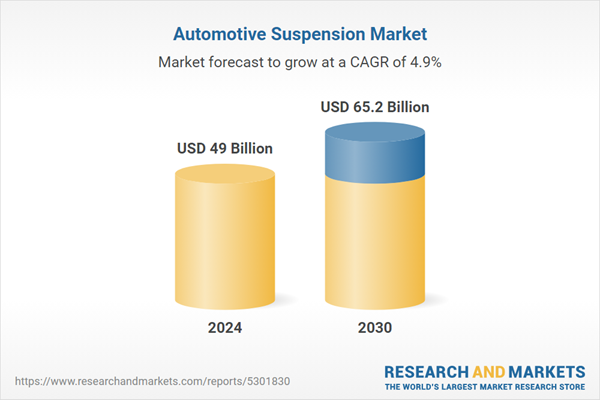Global Automotive Suspension Market - Key Trends and Drivers Summarized
Why Is Suspension So Critical in Automotive Performance and Comfort?
Automotive suspension systems play a vital role in delivering both comfort and control, balancing these two elements to create a smooth, stable ride that meets the diverse needs of drivers and passengers. The primary function of a suspension system is to absorb the impact of bumps, potholes, and uneven terrain, preventing them from directly affecting the cabin and ensuring that the wheels maintain constant contact with the road. This direct contact is essential not only for comfort but also for safety and handling, as it allows the vehicle to respond quickly to steering inputs and maintain traction, even on challenging surfaces. Suspension systems are composed of various components - such as springs, shock absorbers, and control arms - that work in concert to distribute force, minimize body roll, and provide stability in turns. The design and tuning of a suspension system can vary significantly based on the vehicle type and intended usage, with sports cars often featuring stiffer setups for precise handling, while luxury sedans emphasize softer, comfort-oriented configurations. With advancements in materials and engineering, modern suspension systems are now able to enhance performance without sacrificing ride comfort, making suspension an essential aspect of automotive design that directly influences the driving experience.What Are the Key Components of a Suspension System, and How Do They Work Together?
A vehicle's suspension system is composed of multiple interconnected parts, each contributing to its ability to absorb shocks and provide stability. The most fundamental component is the spring, which absorbs the energy generated by road irregularities, preventing it from directly impacting the vehicle's frame and occupants. Springs come in several types, including coil, leaf, and torsion bar springs, each suited to different vehicle designs and load-bearing needs. Paired with springs are shock absorbers, also known as dampers, which control the rebound of the springs, preventing them from oscillating excessively and ensuring the vehicle remains stable after encountering a bump. Shock absorbers use hydraulic fluid to convert kinetic energy into heat, dissipating the energy and allowing for smoother, more controlled movement of the vehicle's body. Control arms are another crucial component, connecting the suspension system to the vehicle's chassis and providing the flexibility needed to handle road conditions while keeping the wheels aligned. Bushings, typically made from rubber or polyurethane, serve as cushions between suspension components, absorbing noise and vibration. Struts, which combine the functions of a shock absorber and a coil spring into a single assembly, are commonly used in front suspension setups, providing support for the vehicle's weight and improving overall stability. Together, these components work in harmony to provide a balance between comfort, control, and durability, enabling the suspension system to meet the demands of different driving environments.How Are Technological Advancements Revolutionizing Automotive Suspension?
Technological advancements have transformed automotive suspension, enabling systems that adapt to road conditions in real-time and offering unprecedented levels of comfort and control. One of the most significant innovations in recent years is the development of adaptive suspension systems, which automatically adjust damping levels based on driving conditions and vehicle speed. Using sensors and electronic controls, adaptive suspension systems can stiffen or soften the ride as needed, providing a sporty, responsive feel during aggressive driving and a more comfortable ride on smoother roads. Air suspension is another advanced technology, particularly popular in luxury vehicles and high-end SUVs, which uses pressurized air in place of traditional coil springs. Air suspension systems allow drivers to adjust the vehicle's ride height, improving aerodynamics at higher speeds or increasing ground clearance for off-road driving. Another revolutionary advancement is the introduction of magnetorheological (MR) dampers, which use a fluid containing magnetic particles that change viscosity when exposed to a magnetic field. This allows for instantaneous adjustment of damping levels, providing a highly responsive suspension system that can adapt to road conditions in real time. Moreover, electronic stability control (ESC) systems have become integral to modern suspension systems, using sensors to monitor vehicle dynamics and selectively applying brakes or adjusting power distribution to maintain stability during cornering or sudden maneuvers.What Factors Are Driving the Growth of the Automotive Suspension Market?
The automotive suspension market is experiencing robust growth, driven by a combination of factors that reflect changing consumer preferences, technological advancements, and evolving automotive design standards. A major factor driving market growth is the increasing consumer demand for enhanced ride comfort and driving dynamics, particularly as more consumers prioritize smooth handling and a refined driving experience. This is especially true in the luxury and SUV segments, where sophisticated suspension systems are expected to deliver both comfort on urban roads and performance in off-road conditions. The rise in electric vehicles (EVs) is also influencing the suspension market, as EVs require specialized suspension setups to accommodate heavy battery packs while maintaining a smooth, stable ride. Technological advancements in adaptive and electronically controlled suspension systems have further fueled market growth, as these systems allow for real-time adjustments to damping and ride height, enhancing both performance and passenger comfort. Moreover, as governments worldwide introduce stricter safety regulations, automakers are increasingly incorporating advanced suspension technologies, such as electronic stability control and adaptive damping, which contribute to vehicle stability and reduce the risk of accidents. The growing popularity of autonomous vehicles (AVs) is another factor, as AVs require highly responsive suspension systems to manage smooth driving dynamics without human intervention, ensuring passenger comfort and safety. Additionally, the expansion of aftermarket services for suspension modifications has opened new opportunities for customization, allowing consumers to tailor suspension settings to their specific driving preferences and needs. Together, these factors are driving significant growth and innovation in the automotive suspension market, as manufacturers continue to develop suspension systems that meet the diverse demands of modern vehicles and deliver improved safety, comfort, and performance.Report Scope
The report analyzes the Automotive Suspension market, presented in terms of market value (US$ Thousand). The analysis covers the key segments and geographic regions outlined below.- Segments: Architecture (Air Suspension, MacPherson Strut, Leaf Spring Suspension, MultiLink, Twist Beam / Torsion Beam, Double Wishbone); End-Use (Passenger Cars, Commercial Vehicles).
- Geographic Regions/Countries:World; United States; Canada; Japan; China; Europe (France; Germany; Italy; United Kingdom; Spain; Russia; and Rest of Europe); Asia-Pacific (Australia; India; South Korea; and Rest of Asia-Pacific); Latin America (Argentina; Brazil; Mexico; and Rest of Latin America); Middle East (Iran; Israel; Saudi Arabia; United Arab Emirates; and Rest of Middle East); and Africa.
Key Insights:
- Market Growth: Understand the significant growth trajectory of the Air Suspension segment, which is expected to reach US$19.2 Billion by 2030 with a CAGR of a 5.2%. The Macpherson Strut segment is also set to grow at 5.3% CAGR over the analysis period.
- Regional Analysis: Gain insights into the U.S. market, valued at $12.9 Billion in 2024, and China, forecasted to grow at an impressive 7.1% CAGR to reach $13.7 Billion by 2030. Discover growth trends in other key regions, including Japan, Canada, Germany, and the Asia-Pacific.
Why You Should Buy This Report:
- Detailed Market Analysis: Access a thorough analysis of the Global Automotive Suspension Market, covering all major geographic regions and market segments.
- Competitive Insights: Get an overview of the competitive landscape, including the market presence of major players across different geographies.
- Future Trends and Drivers: Understand the key trends and drivers shaping the future of the Global Automotive Suspension Market.
- Actionable Insights: Benefit from actionable insights that can help you identify new revenue opportunities and make strategic business decisions.
Key Questions Answered:
- How is the Global Automotive Suspension Market expected to evolve by 2030?
- What are the main drivers and restraints affecting the market?
- Which market segments will grow the most over the forecast period?
- How will market shares for different regions and segments change by 2030?
- Who are the leading players in the market, and what are their prospects?
Report Features:
- Comprehensive Market Data: Independent analysis of annual sales and market forecasts in US$ Million from 2024 to 2030.
- In-Depth Regional Analysis: Detailed insights into key markets, including the U.S., China, Japan, Canada, Europe, Asia-Pacific, Latin America, Middle East, and Africa.
- Company Profiles: Coverage of players such as Benteler, Continental, Fox Factory, Gabriel, Hendrickson and more.
- Complimentary Updates: Receive free report updates for one year to keep you informed of the latest market developments.
Some of the 41 companies featured in this Automotive Suspension market report include:
- Benteler
- Continental
- Fox Factory
- Gabriel
- Hendrickson
- KYB
- Magneti Marelli
- Mando
- NHK Springs
- Rassini
This edition integrates the latest global trade and economic shifts into comprehensive market analysis. Key updates include:
- Tariff and Trade Impact: Insights into global tariff negotiations across 180+ countries, with analysis of supply chain turbulence, sourcing disruptions, and geographic realignment. Special focus on 2025 as a pivotal year for trade tensions, including updated perspectives on the Trump-era tariffs.
- Adjusted Forecasts and Analytics: Revised global and regional market forecasts through 2030, incorporating tariff effects, economic uncertainty, and structural changes in globalization. Includes historical analysis from 2015 to 2023.
- Strategic Market Dynamics: Evaluation of revised market prospects, regional outlooks, and key economic indicators such as population and urbanization trends.
- Innovation & Technology Trends: Latest developments in product and process innovation, emerging technologies, and key industry drivers shaping the competitive landscape.
- Competitive Intelligence: Updated global market share estimates for 2025, competitive positioning of major players (Strong/Active/Niche/Trivial), and refined focus on leading global brands and core players.
- Expert Insight & Commentary: Strategic analysis from economists, trade experts, and domain specialists to contextualize market shifts and identify emerging opportunities.
Table of Contents
Companies Mentioned (Partial List)
A selection of companies mentioned in this report includes, but is not limited to:
- Benteler
- Continental
- Fox Factory
- Gabriel
- Hendrickson
- KYB
- Magneti Marelli
- Mando
- NHK Springs
- Rassini
Table Information
| Report Attribute | Details |
|---|---|
| No. of Pages | 284 |
| Published | December 2025 |
| Forecast Period | 2024 - 2030 |
| Estimated Market Value ( USD | $ 49 Billion |
| Forecasted Market Value ( USD | $ 65.2 Billion |
| Compound Annual Growth Rate | 4.9% |
| Regions Covered | Global |









